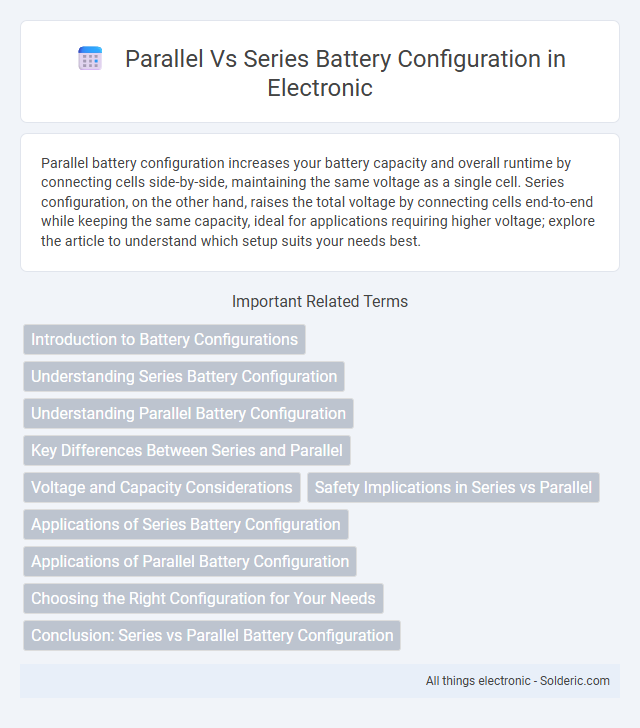Parallel battery configuration increases your battery capacity and overall runtime by connecting cells side-by-side, maintaining the same voltage as a single cell. Series configuration, on the other hand, raises the total voltage by connecting cells end-to-end while keeping the same capacity, ideal for applications requiring higher voltage; explore the article to understand which setup suits your needs best.
Comparison Table
| Aspect | Parallel Battery Configuration | Series Battery Configuration |
|---|---|---|
| Voltage Output | Same as individual battery voltage | Sum of all battery voltages |
| Current Capacity (Ah) | Sum of all battery capacities | Same as individual battery capacity |
| Use Case | Increase current capacity and battery life | Increase voltage for higher power devices |
| Risk | Current imbalance, requires identical batteries | Voltage imbalance, failure in one cell affects whole pack |
| Complexity | Lower wiring complexity | Higher wiring complexity |
| Battery Life Impact | Improved by spreading load across batteries | Decreased if one battery fails |
Introduction to Battery Configurations
Battery configurations are categorized into parallel and series setups, each affecting voltage and capacity differently. In a series configuration, individual battery voltages add up, increasing total voltage while maintaining the same ampere-hour capacity. Parallel configurations maintain the battery voltage but combine the ampere-hour capacities, enhancing the overall energy storage and runtime.
Understanding Series Battery Configuration
Series battery configuration connects battery cells end-to-end, increasing the total voltage while maintaining the same capacity (ampere-hours) as a single cell. This setup is ideal for applications requiring higher voltage outputs, such as electric vehicles or power tools. Proper understanding of series configuration ensures balanced charging and discharging, preventing damage and optimizing battery lifespan.
Understanding Parallel Battery Configuration
Parallel battery configuration connects multiple batteries positive to positive and negative to negative, increasing overall capacity (ampere-hours) while maintaining the same voltage as a single battery. This setup enhances current supply and extends battery life for devices requiring longer operation times without increasing voltage stress. Proper balancing and matched battery conditions are crucial to prevent uneven charge and discharge rates that could damage the batteries.
Key Differences Between Series and Parallel
Series battery configuration increases voltage by connecting batteries end-to-end, resulting in a total voltage equal to the sum of each individual battery's voltage, while maintaining the same capacity (Ah) as a single battery. Parallel battery configuration increases capacity by linking all positive terminals together and all negative terminals together, keeping the voltage the same as one battery but summing the amp-hour capacities. Your choice between series and parallel depends on whether you need higher voltage for power requirements or greater capacity for longer runtime.
Voltage and Capacity Considerations
In a parallel battery configuration, the voltage remains constant while the capacity (measured in ampere-hours, Ah) increases by summing the capacities of individual cells, ideal for extending battery life. In contrast, a series configuration raises the total voltage by adding up the voltage of each battery, while the capacity remains equal to that of a single cell, suitable for powering devices requiring higher voltage. Understanding these voltage and capacity differences is crucial for optimizing battery pack design in applications ranging from electric vehicles to renewable energy storage.
Safety Implications in Series vs Parallel
Series battery configurations increase voltage risk, which can lead to greater potential for electric shock and thermal runaway if cells are mismatched or damaged. Parallel configurations maintain voltage while increasing capacity, reducing voltage-related hazards but raising the risk of current imbalances and overheating if protective measures fail. Proper battery management systems (BMS) and cell matching are critical to ensure safety in both configurations by preventing overcharge, over-discharge, and thermal events.
Applications of Series Battery Configuration
Series battery configuration is commonly used in applications requiring higher voltage output, such as electric vehicles, power tools, and renewable energy storage systems. By connecting batteries in series, the voltage adds up while maintaining the same capacity, making it suitable for devices needing increased power levels. Your high-voltage equipment benefits from enhanced performance and longer operational times through this configuration.
Applications of Parallel Battery Configuration
Parallel battery configurations are commonly used in electric vehicles and renewable energy storage systems to increase overall capacity while maintaining a consistent voltage output. This setup enhances the runtime of devices such as solar power systems and uninterruptible power supplies (UPS) by combining the ampere-hour ratings of individual batteries. Parallel arrangements also ensure safer battery management in high-current applications, providing redundancy and extending the lifespan of battery banks.
Choosing the Right Configuration for Your Needs
Selecting the right battery configuration depends on your power and capacity requirements. Parallel connections increase total capacity (amp-hours) while maintaining the voltage, ideal for extended runtime applications. Series connections raise the voltage while keeping the same capacity, suitable for devices needing higher voltage to operate efficiently.
Conclusion: Series vs Parallel Battery Configuration
Series battery configuration increases voltage by adding the voltage of each cell, suitable for devices requiring higher voltage, while parallel configuration boosts capacity and runtime by combining the current of each cell. Choosing the right setup depends on your device's power needs--use series for higher voltage and parallel for extended battery life. Understanding these differences ensures optimal performance and efficient energy usage in your battery-powered devices.
parallel vs series battery configuration Infographic

 solderic.com
solderic.com